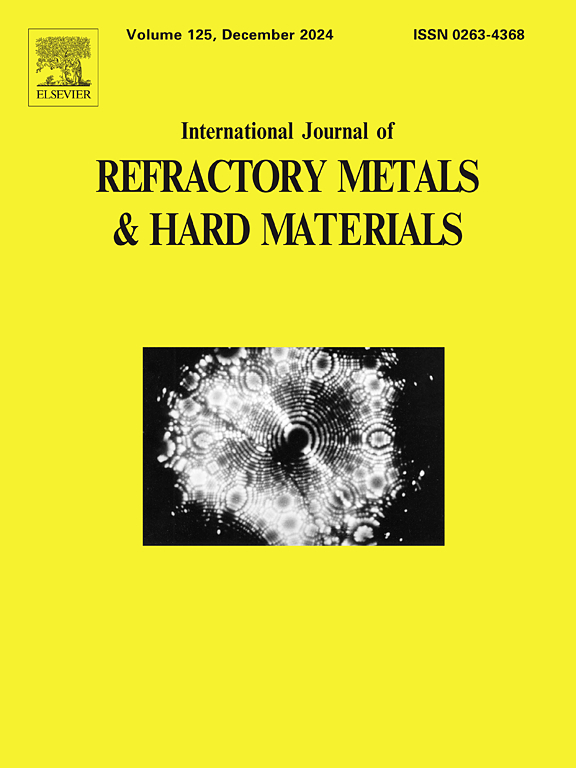Investigation of wear and corrosion resistance of WC-coated Pearlitic railway steel in dry and wet conditions
IF 4.2
2区 材料科学
Q2 MATERIALS SCIENCE, MULTIDISCIPLINARY
International Journal of Refractory Metals & Hard Materials
Pub Date : 2025-03-22
DOI:10.1016/j.ijrmhm.2025.107163
引用次数: 0
Abstract
In this study, the effect of WC coating on the tribological performance of R260 rail steel was investigated by roller-on-plate wear tests and potentiodynamic polarisation corrosion tests carried out in dry and pure water environments. The High-Velocity Oxygen-Fuel (HVOF) method was used for the coating process. The tests were conducted with a weight of 40 N and a sliding speed of 0.03 m/s. An Ag/AgCl reference electrode was also used for corrosion tests in a 3.5 % NaCl solution. To produce cyclic polarisation curves, the experiments were carried out at a scan rate of 1 mV/s within a potential range of ±0.25 V. The effect of WC coating on the wear performance of rail steels was analysed quantitatively with the friction coefficient and volume loss parameters and visually with SEM and 2D-3D topography images. The effect of the coating on the corrosion performance was evaluated numerically with the corrosion potential, corrosion current intensity, and corrosion rate values, as well as elementally and visually with SEM and EDX images. Wear test results showed that the wear volume in WC-coated rail steels decreased by 43.07 % and 46.94 % compared to uncoated rail steels in dry and wet conditions. Corrosion test results showed that the corrosion rate of WC-coated rail steels was lower compared to uncoated rail steels, and the corrosive effect spread to a smaller area.
铁路用wc涂层珠光体钢干湿条件下的耐磨损和耐腐蚀性能研究
在干水和纯水环境下,通过辊对板磨损试验和电位动极化腐蚀试验,研究了WC涂层对R260钢轨摩擦学性能的影响。采用高速氧燃料法(HVOF)进行涂层处理。试验以重量为40 N,滑动速度为0.03 m/s进行。采用Ag/AgCl参比电极在3.5% NaCl溶液中进行腐蚀试验。为了得到循环极化曲线,实验在±0.25 V的电位范围内以1 mV/s的扫描速率进行。利用摩擦系数和体积损耗参数定量分析了WC涂层对钢轨钢磨损性能的影响,并利用扫描电镜和二维三维形貌图像直观分析了WC涂层对钢轨钢磨损性能的影响。通过腐蚀电位、腐蚀电流强度和腐蚀速率值对涂层对腐蚀性能的影响进行了数值评价,并通过SEM和EDX图像对元素和视觉进行了评价。磨损试验结果表明,在干燥和潮湿条件下,wc涂层钢轨钢的磨损量比未涂层钢轨钢分别减少了43.07%和46.94%。腐蚀试验结果表明,wc涂层钢轨钢的腐蚀速率低于未涂层钢轨钢,腐蚀影响范围较小。
本文章由计算机程序翻译,如有差异,请以英文原文为准。
求助全文
约1分钟内获得全文
求助全文
来源期刊
CiteScore
7.00
自引率
13.90%
发文量
236
审稿时长
35 days
期刊介绍:
The International Journal of Refractory Metals and Hard Materials (IJRMHM) publishes original research articles concerned with all aspects of refractory metals and hard materials. Refractory metals are defined as metals with melting points higher than 1800 °C. These are tungsten, molybdenum, chromium, tantalum, niobium, hafnium, and rhenium, as well as many compounds and alloys based thereupon. Hard materials that are included in the scope of this journal are defined as materials with hardness values higher than 1000 kg/mm2, primarily intended for applications as manufacturing tools or wear resistant components in mechanical systems. Thus they encompass carbides, nitrides and borides of metals, and related compounds. A special focus of this journal is put on the family of hardmetals, which is also known as cemented tungsten carbide, and cermets which are based on titanium carbide and carbonitrides with or without a metal binder. Ceramics and superhard materials including diamond and cubic boron nitride may also be accepted provided the subject material is presented as hard materials as defined above.

 求助内容:
求助内容: 应助结果提醒方式:
应助结果提醒方式:


